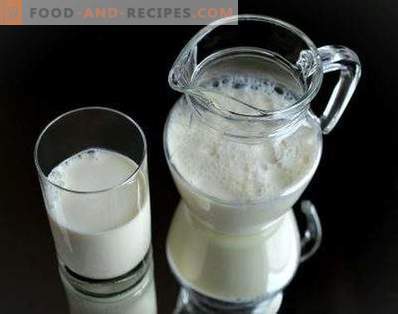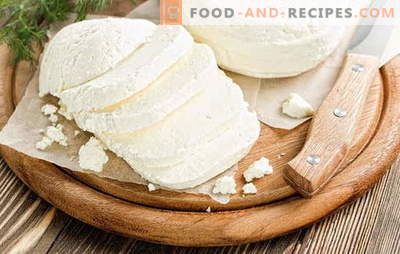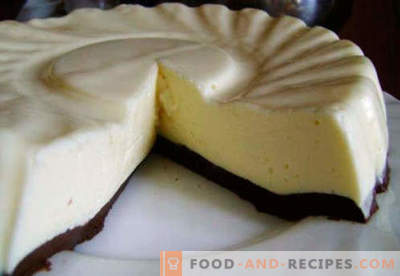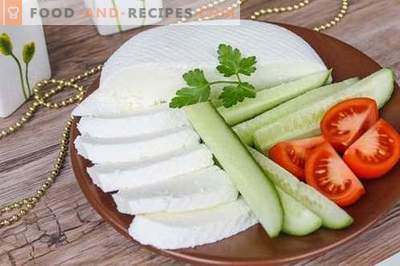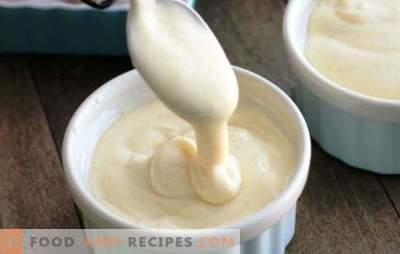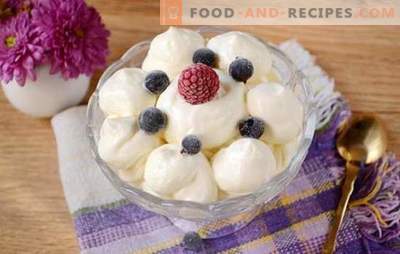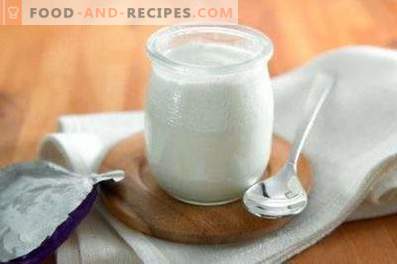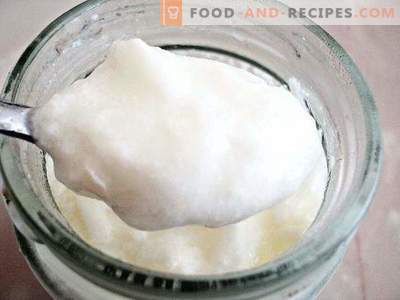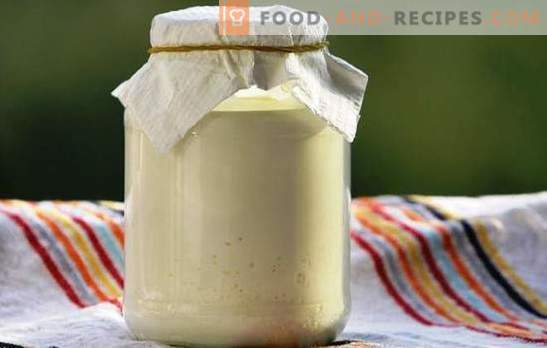
Now in the assortment of sour cream there are so many names that you can stand at the display window with the product for an hour, but you can’t figure it out until the end. , “Sour cream” and other cognates, hiding the composition of the product with affectionate and respectful inscription on the package.
What is sour cream made of? Actually, half a century ago nobody would have thought to ask such a question.
Sour cream - from the word "sweep." It is clear, what and why to sweep away - cream from milk. But after technical progress has made a breakthrough in the dairy industry, sour cream is not only swept away, but extracted and even composed.
When made up of dairy products - it's half the problem, but when there are secret components of non-dairy origin in it, it becomes uneasy - deception is always unpleasant, generates great distrust and causes a defensive reaction.
That's why people are looking for sour cream from milk - a recipe at home. Correctly do what they are looking for.
Between sour cream and sour cream stored in the window for more than 72 hours is a big difference. Even if a sour cream product has a pleasant taste and a thick texture, you will not call this taste milky, and even if you blindfold a person and don’t say what he is trying, he will not detect the smell of cream.
Sour cream from milk - a recipe at home with the basic technological principles of cooking
Let's first calculate a little and compare, in order to come to the correct conclusion about the economic feasibility of making sour cream from milk independently. About recipes for home conditions - a little later.
950 ml of pasteurized natural milk (3.7%) from a good, well-known manufacturer costs 86.00 rubles. A jar of sour cream (25%), weighing 330 g, from the same manufacturer in a retail network costs 90.00 rubles. Total - 176.00 rubles. But this is only 950 ml of good milk and 330 g of sour cream.
Choosing milk in the market. In the bottle, with a volume of 3 liters, should be no less than 350-400 ml of cream. Only choose the right milk. In a glass jar, aged for at least 8 hours, after evening milking, the line of separation of milk and cream is clearly visible: cream (the fat part of milk) floats up and their color is creamy, and the milk remains at the bottom, it is white. 350-400 ml of cream is about 1/5 of the bottle. In very good milk, especially in winter, cream is noticeably more and in the same glassware they take 1/3 part, up to 700 ml. A liter of homemade milk costs an average of 60.00 rubles, respectively, 3 liters - 180.00 rubles. That is, for almost the same money you can get more than two liters of good, whole milk, with a fat content of at least 10%, which, if desired, any housewife can dilute with water on her own, and not pay money for it. To two liters of milk, 700 ml of cream is applied as a bonus, with a fat content of at least 25% - this practically amounts to 2 jars of sour cream, 330 g each, at a retail price made by a good dairy product manufacturer. And yet: even this good manufacturer does not indicate sour cream composition on the package, and how natural milk is sealed in a plastic bottle with a beautiful label, one can only blindly trust, especially if the buyer has long lost the habit of natural, non-powdered dairy products, or does not even remember him.
Well, how? Does it make sense to cook yourself sour cream from milk? The recipe at home is very simple. Perhaps someone remembers, from childhood in the village, how the grandmother collects a cream from the milk can, gathered after settling, on the surface of the milk. Then this cream will turn sour, by itself, and they will be added to borscht or served with pancakes with cottage cheese.
Later, manual separators appeared, then mechanical ones. Yes, it is impossible to make a real cream without cream. This is the main difficulty of its home cooking.
But, recalling the comparative cost of sour cream from milk, the recipe for home will immediately seem to be a salutary straw from the cost of packaging, advertising, transportation, and so on. On this occasion, you can even spend money on a household separator that pays off the counted months, especially if the family loves sour cream, cream, homemade butter and cheese. By the way, using a separator, you can adjust the fat content of the cream, and make sour cream with fat content of 15%, 20%, 25% and up to 48%.
If now there is no money to buy a separator, then start saving in the old grandfather’s way, or rather, in the grandmother’s way. A bit troublesome, but, apart from a spoon, with a handle bent at an angle of 90 degrees, no fixtures will be required. Simply remove the cream that has been settled with a spoon and transfer the jar to the other, clean and dry. You can, of course, argue that it is not safe to use home-made milk, that in addition to the beneficial bacteria and vitamins, it is full of pathogenic microorganisms. Yes, if you are not sure of the purchase, then the milk must be pasteurized, especially if it is intended for children. But does pasteurization really cost as much as the product itself, or there will not be pans in the house to pasteurize it yourself. Many housewives now use multivarks. This is the ideal way to pasteurize milk. It is only necessary to set the timer to 5-7 minutes and the temperature to 70 ° C. It is not necessary to warm up anymore, because beneficial bacteria will die, and nothing will be left of the vitamins.
On the Internet you can find a lot of tips on how to make sour cream from milk, which has a fat content of 3.2%. But sour cream should have a sweet and sour creamy taste, and from milk, almost fat-free, you can get only good yogurt. At least, if you make sour cream from milk, the fat content should be at least 15%. Therefore, we will leave the recipes for yogurt until the next time, and how to make sour cream from milk, in the recipes for the house read below.
1. Sour cream from milk - a recipe. At home we make sour cream in a rustic way (the first method)
Composition:
- Cow milk (evening) 3.0 l
- Sourdough - sour cream 6 tbsp. l
Preparation:
We collect the cream from the bottle with fresh, not pasteurized milk. If possible, then put a jar of cream in a slow cooker, pre-pouring some water into it, bedding mat. We warm at 35 ° C. We take out a jar and enter the starter, at the rate of two tablespoons of previously prepared sour cream for each glass of collected cream. If you are making your sour cream for the first time, then buy a can of sour cream on the market, along with milk. It will be spent on it only once. In the future, leave a few spoons of sour cream to ferment the next batch.
Stir in the sour cream thoroughly with cream. It is advisable to mix the mass with a mixer for a few seconds at low speed in order to break the fat globules well and achieve a uniform, fluffy consistency. In the production of cream is subjected to homogenization, increasing the temperature of heating to 60 ° C for 20-30 seconds. Good technology with pleasure we adopt. Just do not overdo it so as not to get butter instead of sour cream. After 24 hours of aging at a temperature of 18-23 ° C (the time of ripening also depends on the amount and activity of the added starter), transfer the sour cream to a sterile jar with a tight lid and put it in the refrigerator. You can store a week, if during this time do not eat.
2. Sour cream from milk - a recipe. At home we make sour cream in a rustic way (second method)
Raw materials:
- Milk, whole homemade 3 l
Work order:
The easiest way to cook country sour cream does not require any preparation. In a bottle of fresh milk, which already marked the border between milk and cream, put 5-6 tablespoons of sour cream to speed up the ripening. Preheat the milk with a jar, in a water bath. Put the jar in a warm place, near the stove, battery, boiler. Wrap up something warm and wait for souring. The bank should be kept slightly ajar to ensure free access of air to lactic acid bacteria (they also breathe). As soon as you notice that a tight clot has formed at the bottom and the separation of the whey has begun, take a spoon, a clean jar of sour cream and collect sour cream from the surface of yogurt.
3. Sour cream from milk - a recipe. At home, prepare a dietary product
Raw materials:
- Milk homemade, shot (10%) 1 l
- Special starter (mesophilic) 5 g
- Dry cream (15%) 200 g
Manufacturing Method:
Milk is pasteurized, heating to 70 ° C, cooled to 40 ° C and dry cream is introduced with active stirring. The resulting normalized milk is left for 2-3 hours to swell the dry matter, again heated to 60 ° C, mixing with a mixer at low speed: centrifugal force creates pressure, resulting in the destruction of fat globules while heating and this contributes to the formation of a uniform texture. Cool the milk to 20-23 ° C and add the mesophilic starter. Stir again. Pour the milk into the jars, close them and after 5-6 hours, put the milk in the fridge.
4. Sour cream from milk - a recipe. At home we make sour cream from goat milk
Raw materials:
- Goat's milk, homemade
Preparation:
At first - a small introduction. If cow's milk is a valuable product, then goat milk is healing. It is perfectly absorbed by man, because the composition is suitable for enzymes that are involved in digestion. Goat milk contains antibiotics. Its fats are smaller in size than the fats of cow's milk. But precisely because of the structure of proteins and fats, it is impossible to separate the cream from goat milk without a separator. Therefore, for fatty sour cream from goat milk, you must have such a technique.
Separating the cream, they are heated to 45 ° C, then kept for a day at 23 ° C and cooled in the refrigerator.
Second method: to obtain sour cream from 2 l of goat milk, use home-made sour cream from cow's milk (100 g) or thermophilic sourdough (5% of the total) Milk is heated to 30-35 ° C, injected sourdough and allowed to thicken at room temperature, and then stored at 0-6 ° C.
Sour cream from milk - a recipe for the house: tips and tricks
- If you add some fresh milk to sour cream, it will not curdle. This can be successfully used when serving it as a sauce for hot dishes.
- If sour cream needs to be whipped, for example, to make a cream, then add egg white to it so that it becomes thick and has a stable consistency.
